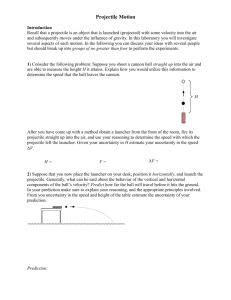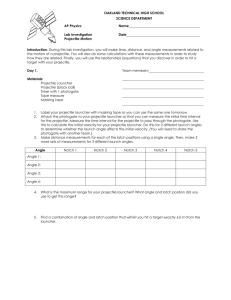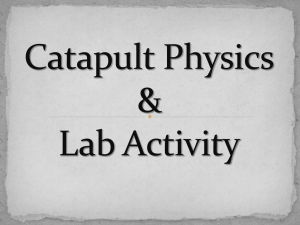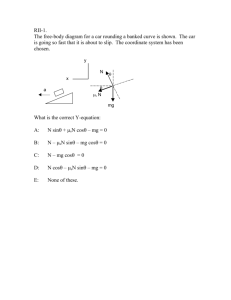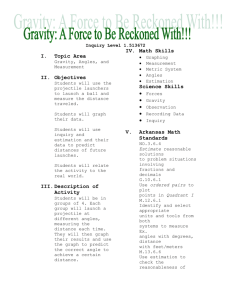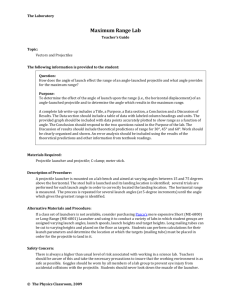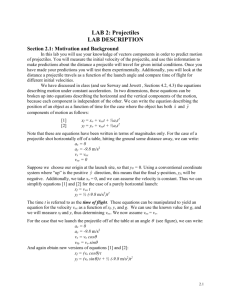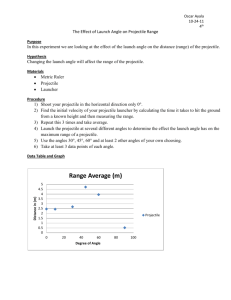Lab2_Projectile
advertisement
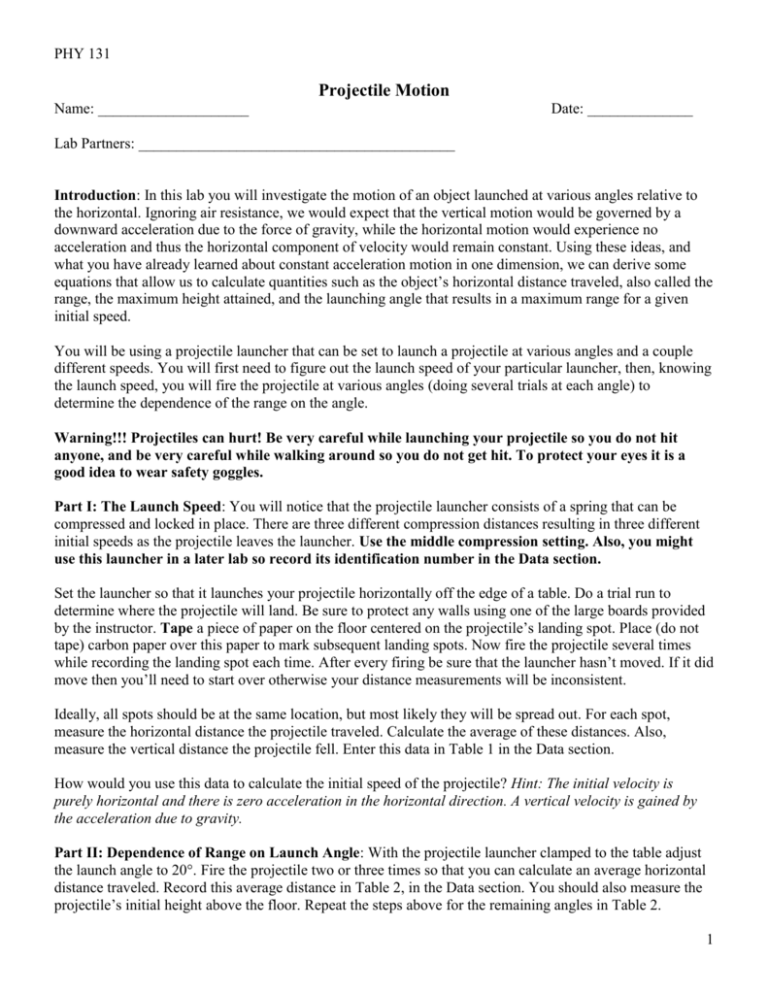
PHY 131 Projectile Motion Name: ____________________ Date: ______________ Lab Partners: __________________________________________ Introduction: In this lab you will investigate the motion of an object launched at various angles relative to the horizontal. Ignoring air resistance, we would expect that the vertical motion would be governed by a downward acceleration due to the force of gravity, while the horizontal motion would experience no acceleration and thus the horizontal component of velocity would remain constant. Using these ideas, and what you have already learned about constant acceleration motion in one dimension, we can derive some equations that allow us to calculate quantities such as the object’s horizontal distance traveled, also called the range, the maximum height attained, and the launching angle that results in a maximum range for a given initial speed. You will be using a projectile launcher that can be set to launch a projectile at various angles and a couple different speeds. You will first need to figure out the launch speed of your particular launcher, then, knowing the launch speed, you will fire the projectile at various angles (doing several trials at each angle) to determine the dependence of the range on the angle. Warning!!! Projectiles can hurt! Be very careful while launching your projectile so you do not hit anyone, and be very careful while walking around so you do not get hit. To protect your eyes it is a good idea to wear safety goggles. Part I: The Launch Speed: You will notice that the projectile launcher consists of a spring that can be compressed and locked in place. There are three different compression distances resulting in three different initial speeds as the projectile leaves the launcher. Use the middle compression setting. Also, you might use this launcher in a later lab so record its identification number in the Data section. Set the launcher so that it launches your projectile horizontally off the edge of a table. Do a trial run to determine where the projectile will land. Be sure to protect any walls using one of the large boards provided by the instructor. Tape a piece of paper on the floor centered on the projectile’s landing spot. Place (do not tape) carbon paper over this paper to mark subsequent landing spots. Now fire the projectile several times while recording the landing spot each time. After every firing be sure that the launcher hasn’t moved. If it did move then you’ll need to start over otherwise your distance measurements will be inconsistent. Ideally, all spots should be at the same location, but most likely they will be spread out. For each spot, measure the horizontal distance the projectile traveled. Calculate the average of these distances. Also, measure the vertical distance the projectile fell. Enter this data in Table 1 in the Data section. How would you use this data to calculate the initial speed of the projectile? Hint: The initial velocity is purely horizontal and there is zero acceleration in the horizontal direction. A vertical velocity is gained by the acceleration due to gravity. Part II: Dependence of Range on Launch Angle: With the projectile launcher clamped to the table adjust the launch angle to 20°. Fire the projectile two or three times so that you can calculate an average horizontal distance traveled. Record this average distance in Table 2, in the Data section. You should also measure the projectile’s initial height above the floor. Repeat the steps above for the remaining angles in Table 2. 1 From your data can you determine the angle that provides maximum range? Make a plot of the relevant quantities to show this clearly. Enter the maximum range angle in Table 3. ____________________________________________________________________________________ Data Launcher Number ____________________ Trial # Horizontal Distance (m) 1 2 3 4 5 6 Average = Vertical Distance (m) = Calculated Initial Speed (m/s) = Table 1 Show calculations for the initial speed of the projectile. 2 Launch Angle Average Horizontal Distance Traveled (m) Initial Height (m) 20° 30° 40° 45° 50° 60° 70° Table 2 Angle for maximum range = Table 3 Questions 1. Is your experimental value for the maximum range angle what you expected? Explain. 2. If the maximum angle was different from what you expected, explain what caused this difference in a few well thought out sentences using physical, or even mathematical, reasoning. 3 3. Using one of your angles and the initial speed determined in part I, calculate the distance that the projectile should travel. Does this result agree with your measured result? Give a mathematical comparison. 4 4. Is the following statement always true: “The angle for maximum range is 45°.” Explain and give at least two examples of why it is, or is not, always true. 5. What were the most significant sources of error in this lab and what did you do to minimize their affect? 5

